Electric heating convectors: how not to freeze in winter in
Widespread heating systems of private homes are heaters running on trunk or liquefied gas. However, for various reasons, it is not always possible to construct such a system. In this case, alternative serve electric heating convectors.
About what there are variations of this equipment, how to choose a suitable model before installing it at home, will be discussed below.
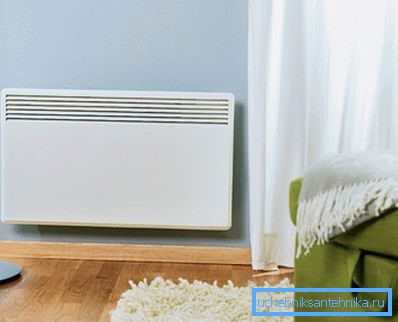
Using electrical appliances to heat a home
Electroconvector Definition
The very concept of convection of air masses implies their gradual movement due to the temperature difference and, accordingly, density. This phenomenon is more or less used by all architects and engineers. No wonder the installation instructions for radiators provide for their installation near the floor (and not near the ceiling).
Unlike the central heating network batteries, in which the coolant circulates (water or antifreeze), the electric heating convector, discussed in this article, heats the air masses using a heating element (without any intermediaries).
Note! Oil heaters, which are also connected to the electrical network, are not included in this category, since the heating elements in them heat the oil, not the air.

It should be noted that, in contrast to outdated models with an open heating coil, modern convectors (for example, NOBO equipment) have a heater built into the radiator-heat exchanger and isolated from the external environment.
Due to such a constructive solution, the units currently being produced have several indisputable advantages:
- Long service life TENA. The surrounding air, which came into contact with an open spiral, significantly reduced the time of its operation. The metal, oxidizing under the action of oxygen, evaporated, which led to breakdowns and frequent replacement of the heater. The electric heating convectors manufactured now are deprived of this disadvantage.
- More comfortable operating conditions. The open coil used oxygen in the room during operation and reduced the humidity level. In the absence of normal ventilation (which is not uncommon in winter), a person, being in a room heated by such a convector, could experience discomfort.
In addition, the open heater burned the dust deposited on it, which, as you understand, also did not contribute to comfort and a healthy atmosphere.
Modern apparatus for space heating consists of the following elements:
- heater (operating at lower than earlier temperatures);
- heat exchanger that protects heating elements and improves the heating of the room;
- decorative linings, giving the unit an attractive appearance and allowing it to more organically fit into the interior of the room;
- mode control.
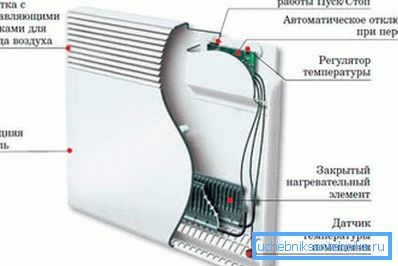
Tip! Currently on sale are models equipped with electronic thermostats. Their price is slightly higher, but they provide more convenience when used. The heater itself will maintain the set temperature regardless of external conditions.
The principle of operation of the electric heater
Modern heater operates as follows. The air in the room enters the heat exchanger, inside of which an electrical heating element is mounted. The air intake is through holes located in the bottom of the unit. TEN is also located there.
After warming up, the air masses rise up and are removed from the body through special grids, which are equipped with the upper part of the body. To make air circulation more efficient, the outlets are angled to the vertical. Thanks to this solution, air masses move along parabolic trajectories.
Next, the described scheme is cyclically repeated, with the result that the heating of all parts of the room is achieved.
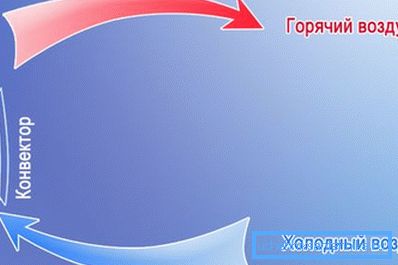
Some models have fans to speed up the warm-up. In this case, the temperature in the room rises faster, but during operation such units emit noise, which many users consider a disadvantage.
The main advantage of modern models of convector is their work at sufficiently low temperatures. During operation, the casing does not heat up above 60 degrees Celsius, so children and pets will not be able to get burned by accidentally touching the case.
Equipment types
To make a more informed choice, it is recommended that you familiarize yourself with the main design features of the climate equipment in question.
By type of electric heating element convectors are:
- Spiral. This is an outdated solution that is currently hardly used. The advantage of such equipment is its low cost, however, this plus is completely leveled by too little useful life.
- Ceramic. A modern, but more expensive solution. Such an electric heating convector warms the air in the room more efficiently, consumes less electricity and looks aesthetically pleasing.
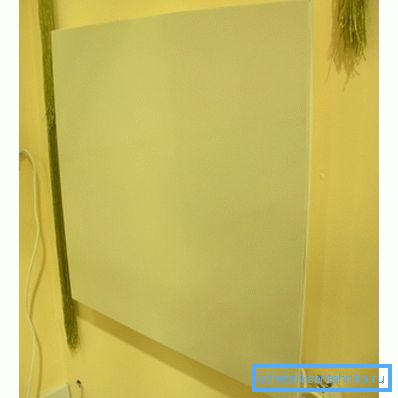
In addition, the devices differ in the methods of installation:
- Floor. Mounted on legs or rollers. It can be placed anywhere in the room where there is access to an electrical outlet.
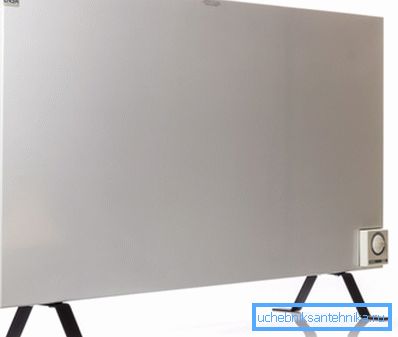
- Wall. Mounted on the wall. Most often located under the windows to create an air curtain and prevent heat loss through the windows. Most models are equipped with special brackets, so the installation can be easily done by hand without the involvement of professional builders.
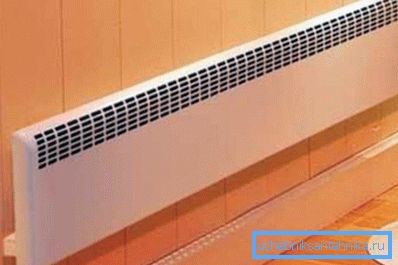
- Built. This type of heater is built into the floor surface. Its main advantage is complete invisibility. It absolutely does not take away the useful space of the room, providing, nevertheless, a comfortable microclimate in the room.
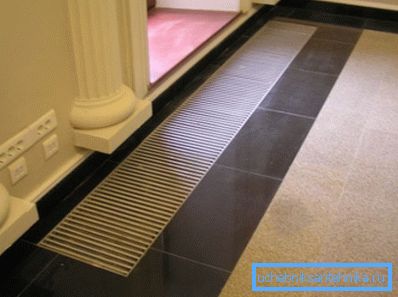
The disadvantage of this solution is that its installation should be provided at the stage of drafting the project.
Types of heating elements
TEN - the main element of the heater. Therefore, when choosing a device, it is necessary, first of all, to pay attention to it.
There are three main varieties:
- Needle. Structurally, it consists of a plate that does not conduct electrical current on which a thread made of an alloy of chromium and nickel is wound. On top of this node is covered with an insulator layer.
A feature of the needle-type convector is its very fast heating, but also almost instantaneous cooling. Therefore, they are additionally equipped with heat exchangers designed from materials with low inertia.
Convectors with needle heaters are strictly prohibited to use in rooms with high humidity levels. This may cause equipment damage and electric shock.
- Tubular. In this case, the thread is placed in a special tube and filled with electrically insulating material, which conducts heat energy well. This element heats up more slowly than the needle, but also keeps the heat more time. Often the tube is equipped with additional fins that heat the air more efficiently.
The heating element is protected from moisture, but during operation it may make clicks and other similar sounds.

- Monolithic. In this case TEN is part of the body. The most efficient design, having a maximum heat transfer coefficient. The disadvantage is costly repairs in the event of a breakdown.
Additional functions
To improve the usability of electric convectors, you can purchase heating devices that have several additional options:
- Thermostat. This device has already been mentioned. On a special panel, the temperature is set, which is maintained by the device. In addition, it saves energy, as the convector itself will reduce power when the temperature on the street increases.
- Control module. Special controllers provide an opportunity to set the desired temperature for each room in the home. Management takes place with a single panel, which is mounted in a convenient place for you.

- Programmer. Allows you not only to set the temperature, but also to change it during the day. For example, in the morning, after the residents leave, the convector can lower the temperature in the house, and in the evening. before they arrive, increase to the desired level.
Advantages and disadvantages of electroconvectors
Positive aspects of using
- Easy installation. For arranging heating with the help of electric convectors it is not necessary to install a bulky boiler, supply gas, install radiators and connect them with pipes. Floor heater can be simply put in the right place, and the wall is fixed with the help of four brackets and the same number of dowels.
- No maintenance required. Gas equipment, according to the regulations, must be periodically subjected to a routine inspection. Convector, working on electricity, does not contain modules that can be served by the consumer.
- Long service life. Most models can be operated for 20 years or more without requiring maintenance and repair.
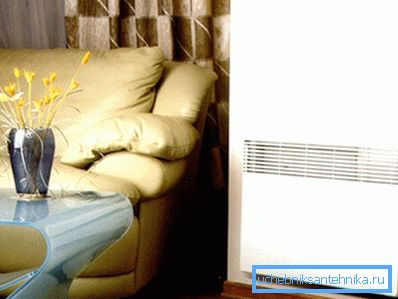
- The efficiency of electric heaters is approaching 100%, which is not the case with heating systems that include gas and, especially, solid fuel boilers.
- Their use allows you to create a more comfortable microclimate. The humidity of the air and the percentage composition of oxygen in the air does not change when the heater is operating.
- Noiselessness The operation of central heating and climate systems with heat transfer fluid is often accompanied by extraneous noise arising during the operation of a water pump and other similar units. The convector, working on electricity, contains no moving parts and components and does not produce noise during operation.
- Fast warming up. The presence of a radiator-heat exchanger allows in the shortest time to raise the temperature in the room to a comfortable one. After a few minutes after switching on, you will feel the effect.
- Cost Electric convector at a price comparable to high-quality water radiator heating. However, unlike the latter, it does not require a boiler, pipes, and so on.
Negative points
The main disadvantage of using this type of heater is the increased power consumption. Therefore, it can be recommended only if there is no centralized gas supply in your settlement or district and, as a result, the cost of electricity is somewhat lower.

Tip! Warm air, heated by a convector, accumulates around the ceiling. Therefore, for more efficient heating of the room (especially with high ceilings), it is desirable to organize the forced circulation of air flows. This can be done using an electric fan or a ventilation system.
Conclusion
Having familiarized with the materials offered to your attention, you will be able to more consciously approach the choice of this equipment before purchasing. The comfort and comfort that you achieve after installing the devices will not make you regret the time spent reading.
And more information you can learn from the video below.